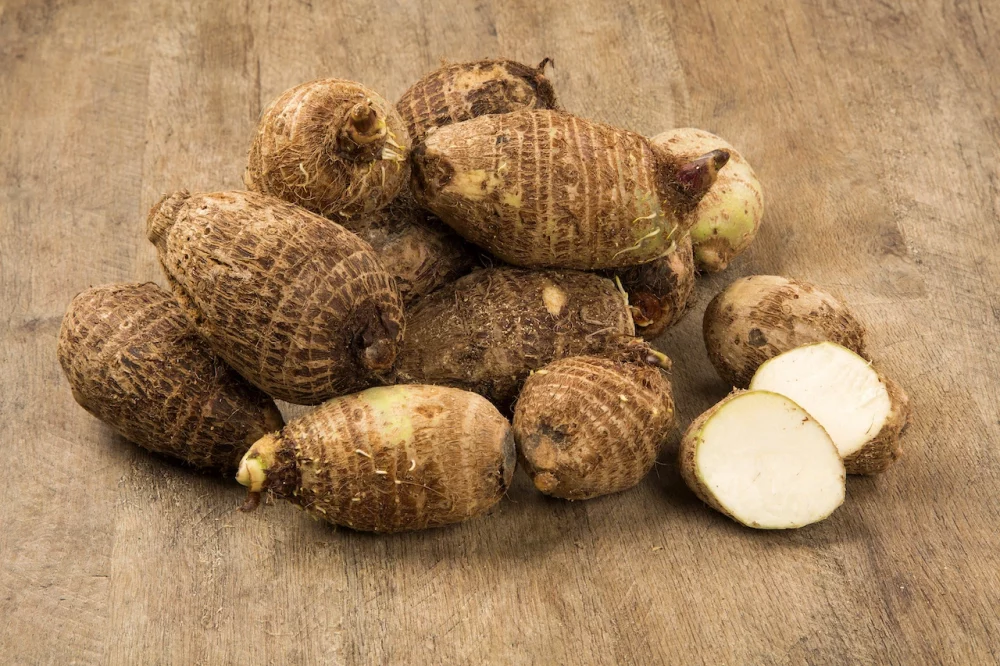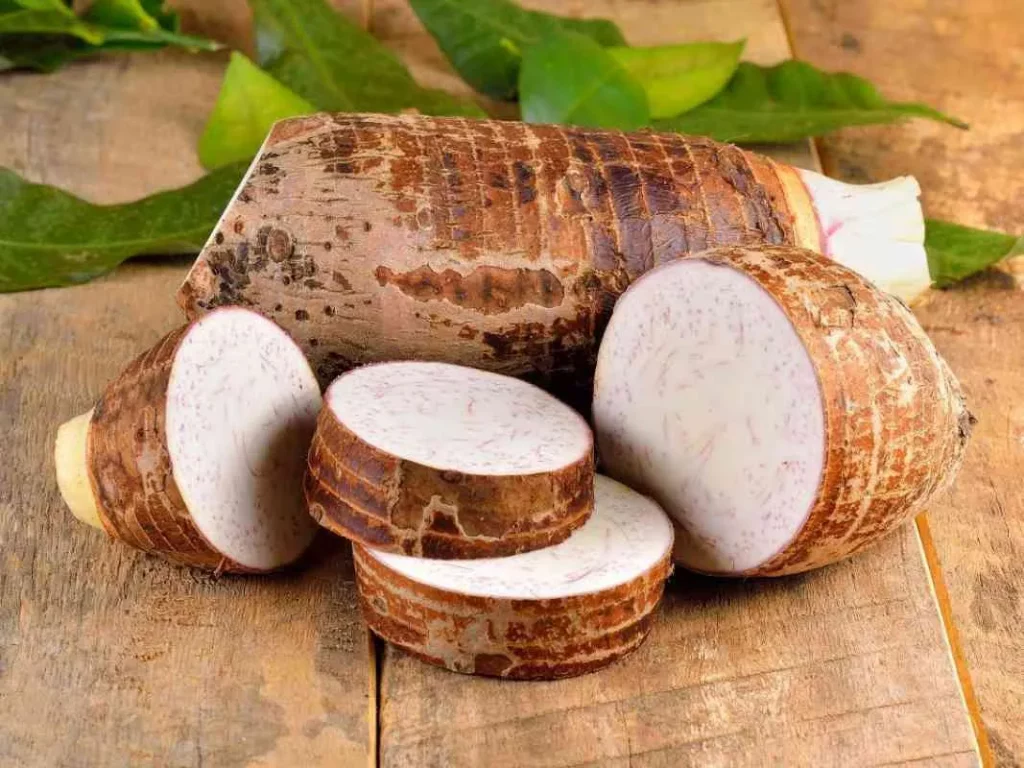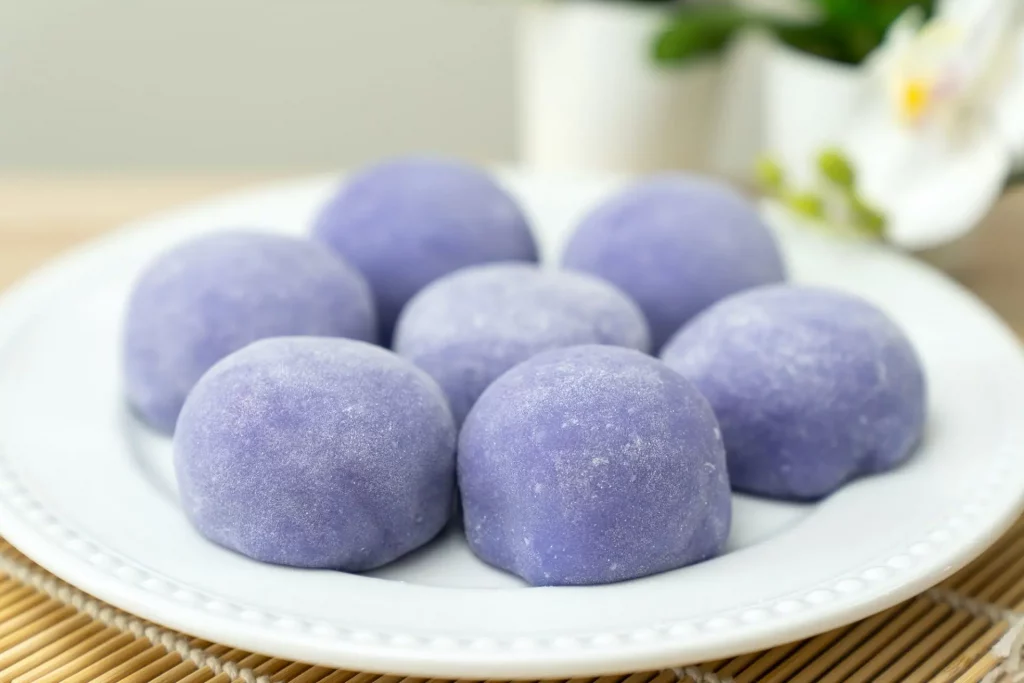Are you an adventurous cook who has just come across taro at the grocery store and are planning an experimental recipe? But before you do that, do you know “what does taro taste like?” This article will help you learn everything about it.

Taro, also commonly known as the dasheen, has a sweet nutty taste that is native to Southeast Asia and Southern India. While there are several varieties of taro cultivated all over the world, there are three root species, in particular, that can be used interchangeably.
Taro roots or corms are gaining the attention of many health enthusiasts for their health benefits. They are a highly nutritious root vegetable that helps fight many diseases. If you are wondering how to turn this sober-looking vegetable into a yummy meal, you have landed at the right place. I will help you figure out the many styles in which taro can be used in various recipes.
But before we move further, you need to keep one thing in mind. Although taro boasts of many health benefits, caution is to be observed while consuming it. Taro is never consumed raw and should be cooked properly before consumption. Come let’s find out more about why this vegetable should not be consumed raw, what it tastes like, its uses, and nutritional content.
What's In The Post
What is Taro?

Taro is a starchy tropical herbaceous plant native to southeast Asia. It belongs to the Araceae family which features elephant ear-shaped leaves. It also comes in two more varieties, eddo and malanga.
Taro is a great source of a large variety of nutrients. In appearance, taro is a potato look-alike that has a dark brown scaly flesh. Its skin can be smooth or slightly hairy, depending on the variety at hand. The inner flesh of taro can be white or cream color with deep purple freckles.
Explore The Taste Of Other Foods We’ve Covered
What Does Taro Taste Like?

Taro is a root vegetable that is used in a variety of cuisines all around the world. It has a mild and slightly nutty flavor. For this reason, it absorbs other flavors quite easily. Once cooked, it tastes similar to sweet potatoes. In terms of texture, taro is firm yet creamy and contains a lot of starch.
Although taro is a root vegetable, it cannot be eaten raw, unlike the other edible vegetables under this category. It contains toxic calcium oxalate which is eliminated once the taro is steeped in water and cooked. Once cooked, it can be used in both sweet and savory recipes.
The leaves of taro also lend a unique nutty flavor and are used for cooking. However, one needs to be careful while handling this vegetable as it may cause itching and skin irritation.
What Does Taro Milk Tea [Taro Bubble Tea] Taste Like?

Taro’s sweet and nutty taste profile is a great addition to many recipes. It is one of the key ingredients to making the famous Asian drink taro bubble tea, which is increasingly gaining popularity.
Wondering what taro bubble tea tastes like? Taro bubble tea is a sweet and nutty drink with a subtle vanilla flavor. In appearance, taro milk tea or taro bubble tea is generally purple in color. But it can also come in pink and white color varieties, depending on the color of the taro roots used. This drink is mostly served cold with crushed ice and tapioca pearls.
What Does Taro Ice Cream Taste Like?

Taro, with its creamy and starchy texture, makes for a great ingredient in ice creams. It provides a natural sweetness and brings along a slight nuttiness and vanilla flavor to ice cream.
The sweet and nutty nature of taro ice cream also depend on the size of the taro roots used. Generally, larger roots have a stronger flavor profile as compared to smaller varieties.
If you are planning to make taro ice cream at home, beware of taro look-alikes. Sometimes, people confuse ube for taro because of its purple color, however, they are two different vegetables.
What Does Taro Powder Taste Like?
If you are a fan of taro bubble tea, you don’t have to step outside each time looking for it. You can enjoy the tea by making it at home using a pre-mixed taro powder.
Taro powder is a purple-colored powder that contains several ingredients. It has a sweet vanilla-like taste and is sweeter than taro itself. It releases a floral aroma. The starchy texture of taro powder helps to thicken beverages and desserts. You can use taro powder in taro bubble teas, milk teas, smoothies, frozen yogurt, and other dessert recipes, too.
What Does Taro Mochi Taste Like?

Mochi is a rice cookie traditionally made in Japan that has many flavors, including taro. It is usually eaten during new year festivities. This bite-sized dessert has now gained popularity worldwide. Taro mochi has a unique flavor. It is subtly sweet and has an earthy taste. Its outer shell is chewy and sticky whereas the filling is soft and sweet. Sometimes, salt is also added to the mixture to balance the sweetness of the taro filling.
Although different types of fillings are used in Japanese Mochi, such as green tea, matcha, peanut, red bean, and more, taro mochi is usually considered the best.
What Does Taro Cake Taste Like?
Taro cake is a popular Hong Kong snack found easily in Chinese restaurants. It is traditionally served during the lunar new year and tastes delightful. While the base, that is, the taro cake, is mildly sweet and nutty in taste, its toppings add an umami flavor to the dish.
The versatile taste of taro cakes makes them easy to pair with both veg and non-veg toppings. Taro cake is usually cut into rectangular slices and is pan-fried before serving. It is dense and soft in texture.
What Does Taro Yogurt Taste Like?
Taro has also made its way into popular yogurt menus. It is blended in yogurts for its creamy texture, sweet, nutty and vanilla-like taste. Taro yogurt is one of the best food options to add to a healthy diet. It is made using a combination of 3 ingredients: taro, heavy cream, and milk.
To make your taro yogurt more delicious, you can add some toppings like Choco chips, fruits, and sprinkles, that gives a great overall appeal.
What Does Taro Leaves Taste Like?
Taro leaves are found in medium and large sizes, having broad heart-shaped leaves. Just like the roots, taro leaves are rich in nutrients that provide many health benefits. They have a mild nutty and metallic taste.
Taro leaves can be boiled, sauteed, fried, and steamed for consumption. But they should not be consumed raw as they can cause skin and mouth irritation just like its corms or roots.
How To Cook Taro?

There are many ways to enjoy taro. You can boil, steam, roast, bake, fry, ferment and use taro in stews. Taro root can be used in both sweet and savory recipes. Before using taro in any recipe, you can easily boil taro in water and then use it in different cuts to one’s liking.
1. Taro Taste After Boiling
Taro has a very mild and slightly nutty flavor. When boiled, the taste of taro is often described as sweet potato. In terms of texture, steamed or boiled taro is soft and almost custard-like, yet still firm and dry at the same time. Boiled taro can be added in a variety of sauces as it maintains its shape and soaks up flavors while adding its own sweetness.
2.Taro Taste After Roasting and Baking
Taro when roasted or baked takes a different taste as compared to boiled. It takes on a sweeter flavor, as the carbohydrates in taro get caramelized and turn into sugar. While roasted and baked taro has a dry and chewy texture, it taste profile matches to that of roasted sweet potato.
3. Taro Taste After Frying
Anything fried tastes absolutely delicious, and so does taro. When fried, taro tastes sweet but stays juicier than its roasted or baked version. You can add a slight sprinkle of seasoning on fried taro to complement its sweet taste. Or, you could also try fried taro with some flavorful dips.
4. Taro Taste After Stir Frying
Think beyond boiling, frying, and baking. Taro can also be stir-fried! Stir-fried taro has a sweet and earthy taste profile. It comes with a crisp and soft texture and can be enjoyed as an accompaniment with rice or noodles.
5. Taro Taste After Stewing And Braising
Taro picks up other flavors well in a recipe due to its mild overall taste. Hence, it makes for a superb ingredient in stews. When stewed or braised, taro tastes sweet and nutty and becomes tender in texture.
6. Taro Taste After Fermenting
Fermented taro is a traditional staple food in the Polynesian diet. It tastes sweet and tangy and has a creamy texture. For its preparation, taro is first boiled and mashed and then fermented to create an acidic flavor. Fermented taro is often used as a side dish to serve alongside savory dishes.
How To Choose The Best Taro?
While selecting your daily fruits and vegetables, it’s important to buy the freshest produce to derive the best taste and quality of your dishes. Thus, while choosing taro for yourself, you should look out for two indicators.
- Taro color: Pick taros that are firm and blemish-free. Another important indicator is the color of taro. If you find uneven colored patches, it means the quality of the taro isn’t fresh. In addition, freshly harvested taro has pinkish or whitish-green stem ends.
- Taro texture: Taro is also available in different sizes. While large taro can be dry and fibrous, small taro variety is moister in texture.
How To Tell If Taro Is Fresh?
While cooking your meals, it’s always good to check for the freshness of ingredients in order to avoid food poisoning. You can easily tell if taro has gone bad with a number of checkpoints.
1. Color
The color of taro is a big indicator to check its freshness. You can easily tell the freshness of taro if it is blemish free and light brown in color. Taro that turns its color to darker brown or yellow has likely gone bad.
2. Texture
Another physical characteristic of a fresh taro is its firmness. If the taro in hand feels soft, it means it’s gone bad. This usually happens when it’s kept for a long time.
3. Smell
Like any food item, smell is an instant indicator revealing the health of your food item. Typically, raw taro doesn’t have a smell, but if you do notice some foul smell that means the taro has gone bad.
How to Store Taro The Right Way?
It’s best to purchase taro as close to the day you plan to cook it as taro does not have a long shelf-life. Taro is a vegetable that is sensitive to temperature fluctuations and humidity. That said, you should keep the following points in mind while storing taro.
At Room Temperature
- Taro should be stored wrapped in a paper bag in a well-ventilated place in your kitchen as it tends to turn soft quickly at relatively high temperatures.
- The soil on taro helps to keep it fresh. So, avoid washing it away much in advance.
- Taro should also be kept away from direct sunlight.
In Refrigerator
It’s best to keep taro at room temperature instead of refrigerator as it slows down its cooking time. However, if you are unable to store it outside, here are a few steps to follow.
- Wipe the taro with the help of kitchen cloth and wrap individual pieces of taro in kitchen towel.
- Put the wrapped taro in an airtight bag and secure its mouth tightly.
- You can then place this packet in the storage compartment of vegetables.
Recipes Where Taro Is Used
If you haven’t used taro as of now, then let me tell you, you are missing out on the good stuff. The taste and color profile of taro makes it a great ingredient that can be used in many ways.
- Taro Fries – Taro fries are the new potato fries that are making a mark on many restaurant menus. They make for an easy and delicious snack and can be served as a side dish in any meal. You can enjoy these fries with dips or season them with your favorite spices.
- Taro With Coconut Milk – If you are a fan of mashed potatoes, then this dish of taro is sure to make you happy. You simply have to boil and mash taro and add a dash of sugar and some coconut milk to create a creamy side dish that is a Hawaiian staple.
- Taro Ice Cream – Homemade ice creams make for the best kinds of ice creams, and taro helps you make just that. You can play with its flavors but be sure of digging into one of the creamiest ice creams.
- Taro Stew – With its starchy consistency, taro is a great ingredient for hearty stews. You can puree them or use whole chunks for a comforting meal.
- Taro Pancakes – Taro can also be used to make delicious pancakes at home. With their mild taste, you can use any toppings for a delectable meal.
- Taro Milk Tea – Also called taro bubble tea, taro can easily be added to beverages. This drink, in particular, consists of three ingredients—purple ground taro root, tapioca pearls, and jasmine tea.
Nutritional Content Of Taro

Taro is a highly nutritious root vegetable. It is rich in fiber, manganese, vitamins, potassium, copper, phosphorus, and magnesium. It helps control blood sugar, reduces the risk of heart diseases, offers anti-cancer properties, is good for gut health, and helps in weight loss.
Taro has a variety of polyphenols and antioxidants. It protects against free radical damage.
| Nutrients | Amount (Serving 100 Grams Of Cooked Taro) |
|---|---|
| Calories | 110 |
| Fat | 0 |
| Cholesterol | 0.2 g |
| Sodium | 11 |
| Carbohydrates | 26.46g |
| Fiber | 4.1g |
| Sugar | 0.4g |
| Protein | 1.5g |
| Calcium | 43mg |
| Iron | 0.55 mg |
| Potassium | 591mg |
| Vitamin A | 4mcg |
| Vitamin C | 4.5 mg |
Conclusion
Taro is a root vegetable loaded with several nutrients and comes in two varieties. Each variety has a slightly different flavor and has its own properties. Having a mild taste, taro makes for a great ingredient in many recipes. However, you should always cook taro before consumption.
Frequently Asked Questions (FAQs)
What is the botanical name for taro?
The botanical name for taro is Colocasia esculenta. It is a tropical plant grown primarily for its edible corms or the root known as taro.
Is taro healthy?
Taro root is an excellent source of dietary fiber and good carbohydrates. It contains high levels of vitamin C, vitamin B6, and vitamin E that helps to maintain a healthy immune system.
Can taro leaves be eaten?
Taro plant has large green leaves, which are commonly eaten throughout the islands along with its corms. But they must be cooked properly first.
What happens when you eat raw taro leaves?
If consumed raw, all parts of the taro are toxic. It has high levels of calcium oxalate in it. If uncooked, it can cause kidney stones and mouth irritation in the form of numbing, burning, or an itching sensation.
Is taro healthier than potato?
Taro root contains more than 6 grams of fiber per cup thus makes for a healthier option.
